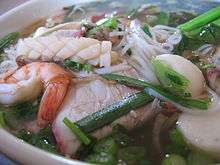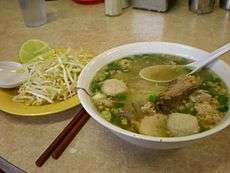Kuy teav
|
Kuy teav (or ka tieu) as served in a restaurant. | |
| Alternative names | ka tieu, hủ tiếu |
|---|---|
| Place of origin | Cambodia |
| Creator | Cambodian Chinese |
| Main ingredients | rice noodles, pork stock |
|
| |
Kuy teav (Khmer: គុយទាវ, Thai: ก๋วยเตี๋ยว kuai tiao, Vietnamese: hủ tiếu; from simplified Chinese: 粿条; traditional Chinese: 粿條, lit: Noodles) is a noodle soup consisting of rice noodles with pork stock and toppings. Kuy teav is generally thought to have originated with the ethnic Chinese groups that settled in Southeast Asian countries. A popular breakfast dish in Cambodia, Southern Vietnam, Singapore, Thailand and other Southeast Asian countries, kuy teav can be found at marketplace (phsar) stalls, roadside vendors, restaurants and in shophouses across the country, and is highly regarded for its clear and soothing broth and dazzling array of herbs, aromatics and other garnishes and condiments.
Etymology
The Khmer word kuy teav refers to flat rice noodles that are cut to various widths including the wide shahe fen; this term also refers to the dish.[1] This word is ultimately derived from kóe-tiâu (粿條) of the Min Nan dialects of China. It is also seen as cognates in Southeast Asia with hủ tiếu in Vietnamese and kuai tiao (ก๋วยเตี๋ยว) in Thai and kway teow in Malaysia, Singapore and Brunei.
In Khmer, kuy teav is properly pronounced IPA: [kuj t̪ieʋ] but is often elided to IPA: [kə t̪ieʋ] (romanized as ka tieu, ka teav, etc.) due to the sesquisyllabic nature of the Khmer language.
Preparation
Kuy teav is prepared with partially dry thin squarish rice noodles cooked by quickly immersing the noodles in boiling water. The noodles are then strained, placed into a bowl, and moistened with nutty, caramelised garlic oil. After dressing with a sticky brown liquid made of oyster sauce, soy sauce and a pinch of sugar, the bowl is then filled with a clear broth made from pork bones, dried squid, and sugar, and seasoned with a bit of fish sauce. Then the meat toppings are added, which may include an assembly of different types of meat, such as pork loaf, minced pork, pork belly, duck, seafood or offal. Availability is the main factor in what toppings are used in kuy teav; some versions can be quite humble and basic, using only some ground pork and perhaps some dried shrimp for protein, while others can be more time consuming and extravagant. Lastly, when the dish is presented at the table, the diner will then add a number of garnishes and aromatics to customise the dish in accordance with his or her preferences.
In Cambodia
In Cambodia, kuy teav is still primarily a breakfast dish, and will typically be sold out by vendors before midday. As the pork broth is intended to be subtle rather than spicy, a plethora of optional herbs and other aromatics is always presented, allowing the diner to adjust the textures and flavours of the dish to his or her liking. In fact, in Cambodia it is precisely the use of garnishes and condiments that defines the main flavour profile of the dish (garlic, limes and pepper are a common flavour trio in Cambodian cuisine), rather than the broth. The dish is always served with the requisite garnishes of a few lettuce leaves, bean sprouts, fresh herbs (such as spring onions (scallions), sawtooth coriander and holy basil), crushed black Kampot pepper, lime juice, and caramelised garlic oil. Many types of chilli (fresh, dried, pickled) and chilli sauce are also normally present at the table, to either add into the broth or to be used as a dipping sauce for the meat toppings, as well as soy sauce, fish sauce and sugar. Kuy teav is also sometimes eaten with deep fried breadsticks, similar to how the Cambodians would eat congee (rice porridge).
Moreover, kuy teav may be presented in one of two ways: with all the ingredients in the soup, or with the soup on the side. Both versions can have exactly the same ingredients but allow the diner to control the balance of flavours, spiciness and textures. When the dish is served this way (“dry” as opposed to “wet”) the dish takes on the appearance of a noodle salad. Finally, the Phnom Penh version of kuy teav is the most extravagant and features the most embellishments, owing to the city’s historical wealth and importance. Kuy teav Phnom Penh may contain some or all of the following toppings: sliced pork belly, ground pork, pig’s blood jelly, chopped pork offal (such as intestine, heart, liver and lung), roast duck, Mekong River prawns, sliced fish cake and squid. Modern-day versions of kuy teav featuring beef, chicken or seafood (rather than the original pork broth) have also evolved, but the plethora of garnishes that distinguish kuy teav remains the same.
International variants


As both Thailand and Vietnam have large ethnic Khmer populations (over a million people each), in addition to the common thread of centuries of Chinese migration, this dish is also popular in neighbouring countries, as well as countries that have a large expatriate Khmer population. At Cambodian restaurants in France, the United States and Australia, kuy teav is considered a staple. The Phnom Penh version of kuy teav (called kuy teav Phnom Penh in Khmer and hủ tiếu Nam Vang in Vietnamese) is hugely popular in southern Vietnam, having been introduced to Vietnam some time during the 1960s (while the original basic version of kuy teav was probably introduced much earlier). For a long time, the most common form of kuy teav/hủ tiếu contained only slices of roast pork for protein and no seafoods—only a few restaurants specialized in hủ tiếu Nam Vang in its original form, which also included liver, intestine, tongue and ground pork. However, over time, Vietnamese restaurateurs started adding shrimp and crab to the basic pork hủ tiếu, thus blurring the line with hủ tiếu Nam Vang. Hủ tiếu Mỹ Tho, another version of the basic pork hủ tiếu, is popular in Mỹ Tho. This version contains one or more slices of boiled pork hind leg, including the skin, and the noodle is a more chewy variant of the rice noodle. Most overseas restaurants serve hủ tiếu Mỹ Tho as hủ tiếu dai, with glass noodles instead of the traditional extra chewy rice noodle, leading to some confusion by many overseas' customers.
See also
References
- Cambodia: Daily life and social customs. Britannica Online Encyclopedia. Rpt. in Cambodia. N.p.: n.p., n.d. N. pag. Encyclopædia Britannica Online. Web. 15 May 2010.
- ↑ Nath, Chuon. Khmer-Khmer Dictionary. Buddhist Institute of Cambodia, 1967
